Pilot fighter with UVP MiG-23PD
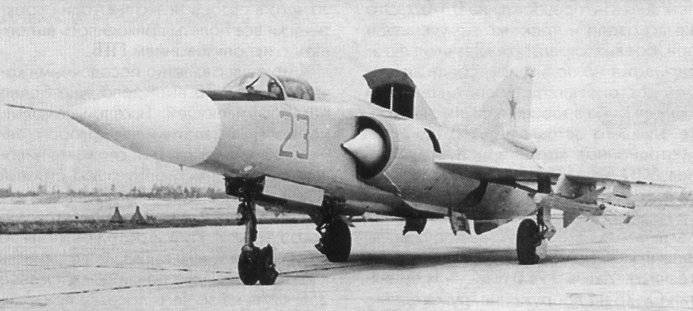
Behind the cockpit of the fighter inside the fuselage of the fighter, it was planned to vertically install a pair of additional lifting engines RD36-35 (thrust each 2350 kgf) developed in the OKB-36 MAP under the guidance of the chief designer Kolesov P.A. Additional engines had to be switched on only during takeoff / landing modes, in order to create a tangible increase in wing lift. The installation of additional lift engines in 1966-1967 worked on the experimental E-7PD (23-01, later received the designation MiG-23PD), which was created on the basis of the serial MiG-21С. The MiG-23 (23-01) was close to the MiG-21 fighter in terms of its aerodynamic layout, it had horizontal tail and a medium-delta wing. This used a new design of the fuselage. A new engine was installed on the aircraft - a turbojet engine with an afterburner chamber Р27Ф-300 (thrust 7800 kgf), developed under the guidance of general designer Tumansky S.К. in OKB-300 MAP - and side air intakes with a semicircular cross-section. In this case, the entire nose of the fuselage could be used under a powerful radar station. The construction of an experienced MiG-23, having lift engines, began in March of the 1966 year, it lasted 8 months. On November 30, the 1966 was relocated to Zhukovsky at the LIS OKB, where prior to the delivery of the flight copy of the Р27Ф-300, its ground testing was carried out. The first copy of the MiG-23 (23-01), which was the only one, was not equipped with the command radio guidance equipment and a radar station — instead, they were equipped with auxiliary protection units (monitoring and recording equipment).
There was no gun on the plane yet. The first flight of the aircraft 23-01 (onboard №23) passed 3 on April 1967. The car was driven by test pilot Ostapenko P.M. July 9 Ostapenko demonstrated the takeoff / landing of a new fighter at Domodedovo at an aviation parade. However, work on this aircraft soon ceased.
Even before the testing of the experimental 23-01 aircraft began, it became clear that the scheme with additional lifting engines had no great prospects. Additional engines occupied a lot of space in the fuselage, significantly reducing payload and useful fuel for fuel, and only a few minutes were used during the flight. Considering the requirement to increase the duration and range of the flight, for the further implementation of the program for the MiG-23 fighter aircraft, another version of the aircraft layout was adopted, which included the use of a variable geometry wing.
The following is a description of the aircraft taken from the book of OPLOV BA. "Notes of the test pilot."
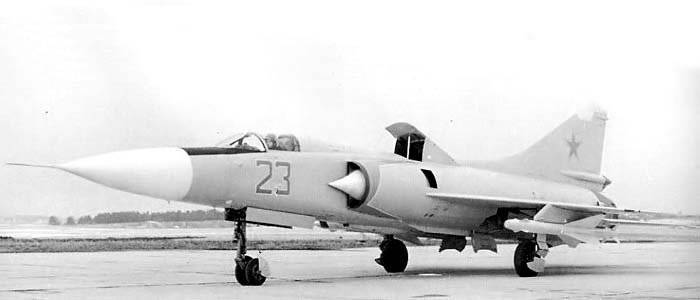
“All over the world, in those years, work was intensively carried out on planes with vertical take-off and landing and planes with short mileage and run. In France, tested the plane "Balzac", which was built on the basis of the Mirage 3 fighter, having engines to create vertical thrust. The British successfully used the "Hariep", one engine of which served for horizontal flight and vertical take-off / landing. In the USSR, the Yakovlev Design Bureau created the Yak-36, which had a main engine and lift engines, which worked only during takeoff / landing. We and “Sukhovtsy” investigated the possibility of reducing the landing and take-off distances with the help of small vertical thrust engines, which could not lift the plane vertically, but seemed to reduce the weight of the aircraft. For this purpose, Cy-15DB was built at the Sykhoi Design Bureau on the basis of the Cy-15 interceptor fighter, installing lifting engines on it. We put two lift engines on a slightly modified MiG-21 fighter. The experimental aircraft was called the “23-31 product”. Ostapenko P.M. lifted this car in June 1966 of the year.
Lifting engines on the 23-31 aircraft were located in the middle part of the fuselage. This significantly reduced the volume of fuel tanks, and therefore the flight time of the aircraft was reduced to 15-17 minutes. The landing gear was not removed because it had no place to remove due to the installation of lift engines, so the car did not rise above 1,5 km. And there was nothing for the plane to do at high altitudes, since it was mainly the behavior of the aircraft that was tested during takeoff and landing. Exhaust nozzles of lifting engines were supplied with specials. grids that deflected the gas stream back to 10 hail. and forward on 5 hail, which increased the overall thrust at takeoff, and the forward deflected jet during landing played the role of a gas brake.
Takeoff and landing were not easy. Exhaust jet, created by lifting engines, spread out y of the ground to the sides, creating a sucking effect; as the altitude and speed changed, the effect of this effect affected the lift force of the aircraft, as well as its controllability and stability. If there were a few problems during the take-off — a slight rebalancing, that is, a change in the pitch angle with the fixed control knob — after the takeoff from the ground was not a particular difficulty for the pilot, then during the landing, besides rebalancing, this “leakage” caused an energetic decrease in the apparatus and the same inhibition. In this regard, just before landing, it was necessary to increase the thrust of the main engine to the maximum, and in some cases even turn on the compression ...
While sorting out the flight schedules with Fedotov, we came across Ostapenko's report on the implementation of the flight task on the 23-11 aircraft, where he wrote: “Taking off at maximum load, landing at the afterburner”. At first we thought that Petr Maksimovich was wrong, but he didn’t think to be wrong - as it turned out, that was exactly what happened ...
All this greatly complicated the execution of takeoff and landing on this machine, and the big gain in the length of the take-off distance due to the apparent weight loss did not work.
Despite this, the construction of the previously laid prototype aircraft was carried out according to this scheme, and in March 1967 raised the MiG-23-01, a beautiful airplane with a sharp nose, side semicircular air intakes, a new powerful engine. On it, Ostapenko made several dozen flights, flew to Domodedovo at a parade, and on this plane finished his history - they gave him somewhere, to the museum, in my opinion, in MAI. A couple of flights on the MiG-23-01 except Peter Maximovitch, made Fedotov.
Such a scheme did not justify itself, although the mileage and run on the MiG-23-01 were relatively small - it was too expensive to carry engines that were used only during takeoff / landing, which took the place of equipment and fuel.
“Sukhovtsy”, flying on Сy-15ВД - mainly, the test pilot E.S. Solovyov, - and having tested the T-6 with elevating engines, they understood that “the game is not worth the candle”. After that, they built a T-6 with a variable sweep wing - the famous bomber Cy-24.
I was appointed understudy Ostapenko, which greatly raised me in my own eyes. I accompanied Petr Maksimovich several times with a cameraman on the MiG-21, and then I myself flew on this interesting plane. Unfortunately, I soon had to fly on a long trip, and I made subsequent flights on this plane in late autumn, when the main part of the program was finished. It didn’t do without “introductory” - during one flight I took off without being convinced that one lifting engine reached the “maximum”. Of course, I made a blunder, for which I received a small “plug” from Fedotov, but the green light of the engine output signal for maximum mode was very poorly visible, especially in bright light.
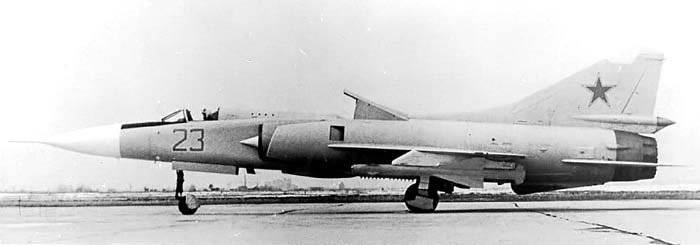
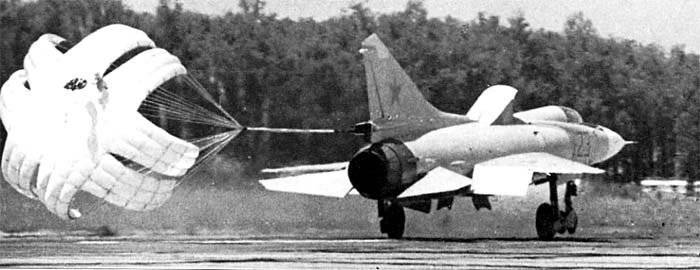
With the advent of the MiG-23-01, the first experimental vehicle equipped with elevating engines flew little during the tests, but it was decided to show it at Domodedovo parade, so several dozen training flights and a demonstration flight took place during the parade. Then this car finished its flight existence. "
Aircraft performance characteristics:
Modification - MiG-23PD;
Wingspan - 7,72 m;
Length - 16,80 m;
Height - 5,15 m;
Wing area - 40 m2;
Empty weight - 11200 kg;
Maximum take-off weight - 18500 kg;
Type of the main engine - TRDF P-27-300;
Type of auxiliary engine - 2ХТРД РД-36-35;
Traction unformed main engine - 7800 kgf;
Unforced auxiliary engine - kgn; 2x2350;
Maximum speed - 1600 km / h;
Crew - 1 man;
Armament - 23-mm gun.
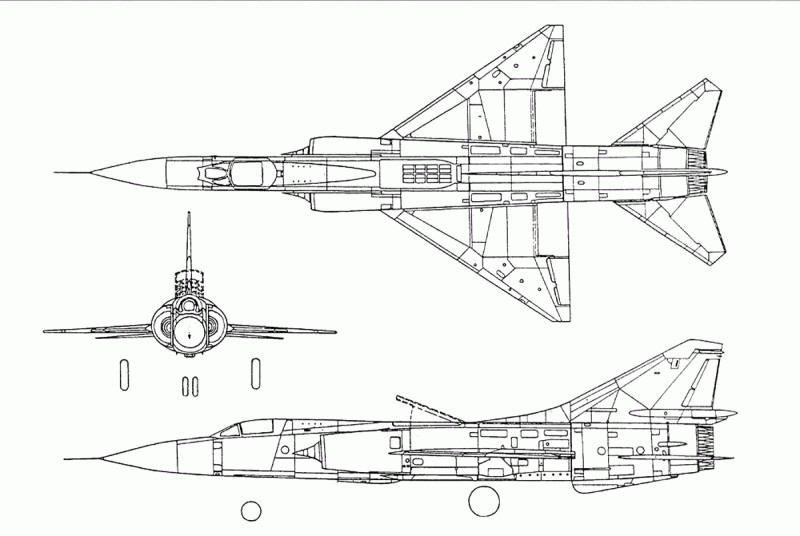
Information